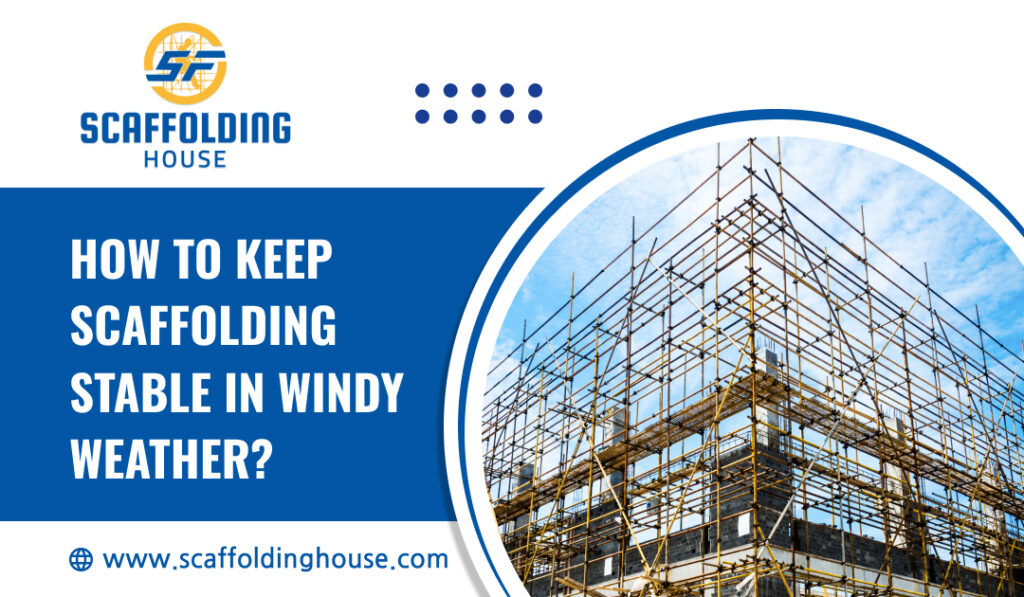In windy weather, it’s crucial to keep your scaffolding safe and secure. Heavy wind or rain can pose significant risks, not only to workers but also to the surrounding properties and the public. Proper installation, design, and maintenance of scaffolding are crucial to withstand adverse weather conditions. If you are in construction, you may have to deal with numerous types of scaffolding systems to accomplish the tasks. In this case, make sure to follow safety tips to keep your scaffolding and workers safe. In this blog post, we’ll share a few tips and tricks to keep your scaffolding safe and stable during windy weather.
How long scaffolding system be left up?
When you install or set up a scaffolding system, how long it can be left will depend on several factors. The time duration is based on various factors, such as the nature of the project, local regulations, and weather conditions. Usually, scaffolding must remain in place for as long as it’s required to complete the work.
For short-term projects, you can keep scaffolding in place for just a few days or weeks. However, for larger renovation projects or construction, it can be left for several months or even longer. It’s essential to frequently check or inspect the scaffolding throughout its use to ensure it remains safe and stable.
It’s worth considering that leaving scaffolding for an extended period without use can increase the risks. Prolonged exposure to scaffolding can compromise its quality and structural integrity. Therefore, it’s essential to disassemble scaffolding promptly once the tasks are complete or if there is a significant pause in the construction work.
How can scaffolding survive heavy winds?
While professional scaffolders avoid working on scaffolding during adverse weather conditions, this doesn’t mean that scaffolding itself should be impacted. In simple words, during stormy or windy weather conditions, a scaffolding system should always remain in place and not be blown over. In case the scaffold structure is blown away, it means that the scaffold structure has not been constructed accurately. Scaffolding quality also matters when installing scaffolding structures, so it’s crucial to buy a scaffold from trusted scaffolding manufacturers. Here are a few tips that can be followed to ensure scaffolding is in place during heavy wind:
Anchoring and Bracing:
- Secure Ties and Braces: It’s essential to use robust tie-ins to the building and choose additional braces to add extra stability, especially in areas with high wind exposure.
- Wide Base Design: It’s crucial to pay attention to the base of the scaffolding to improve stability, to have a wider footprint, and resistance to external forces.
- Counterweights: For freestanding scaffolding structures, it’s advisable to use ballast weights to anchor the structure firmly to the ground to prevent it from tipping.
Material Selection and Wind Resistance:
- Weather-Resistant Materials: Choose components of scaffolding that are made from corrosion-resistant materials like aluminum or galvanized steel, ensuring they can withstand exposure to moisture or wind.
- Wind-Resistant Design: Don’t forget to include protective barriers to reduce wind resistance on the scaffolding structure.
- Inspection and Maintenance:
- Daily Inspections: It’s crucial to frequently inspect scaffolding for any damage, loose connections, damaged components, or signs of wear and tear, especially after strong storms or winds.
- Adjustments: Make necessary adjustments to the scaffolding, such as adding bracing or re-anchoring, to maintain its stability.
Worker Training and Communication:
- Safety Procedures: It’s recommended to train your workers on safety methods and prepare them for working in adverse weather conditions, including when they should stop work due to storms.
- Clear Communication: Establish clear communication channels and well-rehearsed emergency procedures to ensure a smooth response.
Other Considerations:
- Secure Loose Materials: Make sure to check that all scaffold boards are properly secured and that any netting, sheeting, or temporary roofing is adequately secured or removed when required.
- Slip-Resistant Surfaces: Ensure to use of slip-resistant materials on platforms or walkways to prevent falls during wet weather conditions. For example, when you buy a tower scaffolding, check that its platform is slip-resistant.
- Clear Access: Pay attention to the clear access to the scaffolding to ensure easy movement of tools, personnel, and materials.
Conclusion
When using a scaffolding structure, you need to pay attention to numerous things to keep your scaffold stable even during windy weather conditions. By following the above-mentioned tips, you can ensure that your scaffold will survive in adverse weather conditions. You also need to buy high-quality scaffolds to ensure their longevity of the scaffolds.

